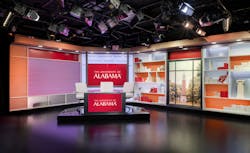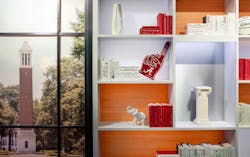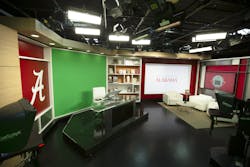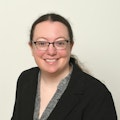How Adaptive Reuse Transformed a Hospital into a Cutting-Edge Content Studio
Forward-thinking colleges and universities are at a crossroads. They must balance the needs of on-campus students attending classes in brick-and-mortar buildings with the needs of non-traditional students, who may attend classes entirely online and may have never visited campus.
A cutting-edge facility on the University of Alabama’s Tuscaloosa campus is aimed directly at reaching students who need to attend classes online. A former campus hospital was converted into state-of-the-art content studios and offices via adaptive reuse. The facility now houses the Office of Teaching Innovation and Digital Education (OTIDE), formerly the College of Continuing Studies, which empowers remote learning by producing high-quality content that’s interactive, informative and educational. Instructors can develop a curriculum that includes video conferencing, online video-streamed classes and interactive study and have it produced professionally in the studios.
“We do our best to make [UA Online courses] as engaging and interactive as possible, so those students—wherever they might be, across the region, country or world—can have the same enriching educational experience,” explained Allan Guenther, director, instructional technology, UA Online, for the University of Alabama. “It might be different, but we hope it’s just as effective in terms of the knowledge they’re learning.”
UA Online offers over 2,300 distance learning courses to students each year, according to Amanda Ingram, executive director of online and continuing education for OTIDE. UA Online’s team of instructional designers work with OTIDE’s media production team to develop roughly 225 courses every year for distance students who are enrolled in bachelor’s, master’s and Ph.D. programs.
Constructing the Content Hub
Provost Studio designed the studio alongside partners Phil Widmer Designs, SH Acoustics and Innovative Environments, while Williams Blackstock Architects served as the Architect of Record, tackling the exterior and base building.
“Aside from the existing space having a big hole in it from the skylight, the space itself was adjacent to a main entry point into the campus,” explained Provost. “We were basically right up against a big thoroughfare for circulation and a pickup for large dumpsters of trash. We didn’t have the option to change where [the production studios] were located in the building, so the team’s acoustic engineer had their work cut out for them. Our broadcast video production team went on a walkthrough at the same time as the architecture and engineering team, so we understood what the challenges were from the very beginning, which ensured that we all talked about what the challenges were and solved them.”
This coordination proved to be highly valuable. The two hubs—the architecture and engineering base building team and the broadcast video production team—communicated constantly to ensure everyone was always on the same page. “Our lighting designer, while he was laying out the electrical and lighting system, we would get the electrical engineer on the call to give them loads and what to anticipate as opposed to doing it afterward or after the system had been designed,” Provost said. “That direct coordination sooner rather than later was really good.”
The high degree of coordination made the project team nimbler, which enabled them to meet the university’s three ultimate asks: flexibility, versatility and ease of setup. The new facility needed to be highly flexible to deliver multiple types of content from spaces that can be transformed quickly and easily.
“They wanted the ability to have standup presentations, do one-on-one discussions and have a desk with a laptop and an instructor with direct instruction,” explained Provost. “Previously, they were doing all that with a green screen.” Now, instructors can choose from a large or small studio, each with a control room, and choose from five studio configurations:
- One-on-one interview with a monitor
- Standup with a monitor
- Standup with a green screen
- Roundtable discussion with a platform
- Roundtable discussion without a platform
Many of the furnishings, such as walls and desks, are on casters so they can be moved out of the way easily when needed.
“They can physically transform the space like a Swiss Army knife,” Provost said.
Producing Quality Content
“A lot of times they’ll come in with PowerPoints, and our team will find B-roll or stock photos. We can put them on our green screens and immerse them in something—for example, if they’re in a history class, we can put them on the Great Wall of China,” said Lee Laska, assistant director, Creative Academic Media Services (CAMS), for the University of Alabama. “If it’s a two- to three-person interview, we can do that as well. One of the cameras they installed is a sky cam located in the lighting grid—it worked very well for overhead when we had to do a pig dissection for a biology class. We can do anything from old school physical [learning] so it can go into a virtual environment.”
Translating these traditional classroom experiences into an online environment isn’t an easy task, but the strategic use of the content studio’s technology helps keep learning fun and engaging. “Technology in general has the ability to bring the remote audience closer to the content,” Provost said. “It’s going to enable instructors to communicate in a more visual way… It brings you closer to both the instruction and the content.”
The University of Alabama has prioritized maintaining the quality of UA Online and the content production facility, which is key to its long-term success, Guenther added. Other institutions looking to improve online course quality should understand that a facility like this requires a real commitment from its parent institution.
“You’ve got to give [the facility] those resources it has to have if you really want to do it right,” Guenther said. “There needs to be a commitment to not only build a studio but maintain it and keep it on the cutting edge for the future. We’ve been fortunate to have that. I think there’s an understanding of how important it is to our courses and our program being at a high level.”
Maintaining the facility’s highly modern nature requires not only a financial commitment but a creative one too. Parent institutions and facilities teams should furnish their content studios with an eye on what’s next, enabling them to meet future needs with equipment that can facilitate multiple modes of learning.
“Don’t be afraid to be creative,” Laska urged. “Stay on top of the trends. Relate on that level, because students are very savvy, and you have to be flexible and ready to change.”
About the Author
Janelle Penny
Editor-in-Chief at BUILDINGS
Janelle Penny has been with BUILDINGS since 2010. She is a two-time FOLIO: Eddie award winner who aims to deliver practical, actionable content for building owners and facilities professionals.



